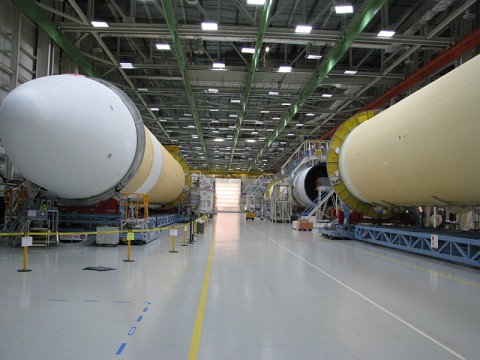NASA’s Marshall Space Flight Center
 Huntsville, AL – Orion’s first mission, Exploration Flight Test-1, or EFT-1, is less than a year away now, and the team building the spacecraft is meeting milestones left and right as they prepare the vehicle for its debut.
Huntsville, AL – Orion’s first mission, Exploration Flight Test-1, or EFT-1, is less than a year away now, and the team building the spacecraft is meeting milestones left and right as they prepare the vehicle for its debut.
The Orion crew module that will fly 3,600 miles above Earth on the spacecraft’s first mission is continuing to come together inside the Operations and Checkout Building at NASA’s Kennedy Space Center in Florida.

They’ve placed it on a work stand and begun drilling the holes necessary to attach it to the module. The heat shield is scheduled be put in place in the spring.
Once the heat shield has done its job getting Orion through the Earth’s atmosphere after its two orbits around Earth, it will be up to the parachutes to do the heavy lifting, literally. A total of 11 parachutes will be used for various landing functions, but three main parachutes that together could almost cover a football field ultimately will slow Orion’s descent down to less than 20 miles per hour for the finale: a relatively gentle splashdown in the Pacific Ocean.
The three main parachutes that will be used for EFT-1 were installed on the vehicle this month. A crane lowered each of the 300-pound main parachutes into place near the top of the capsule, and technicians in clean suits fit them into their compartments. They’ll be deployed using three smaller pilot parachutes that pull them out after the preceding drogue parachutes have done the initial work of slowing the vehicle down.
While those activities are preparing the spacecraft in Florida, the rockets that will launch Orion into space are nearing completion in Decatur, AL, home of United Launch Alliance’s final assembly facility. The core, port and starboard boosters of the Delta IV heavy lift rocket that will be used for EFT-1 are all final assembly, with the starboard section leading the charge.
It’s currently in final acceptance testing, while the RS-68 engine was recently installed on the core booster, and the propulsion and wire harness assemblies are being integrated into the port booster.
The rocket is scheduled to be completed and shipped to Florida in the spring.
With all this activity wrapping up 12 months of arrivals, installations and tests, 2013 has been a good year for the Orion Program. In fact, the only thing that could top it would be 2014 and the launch of EFT-1.


